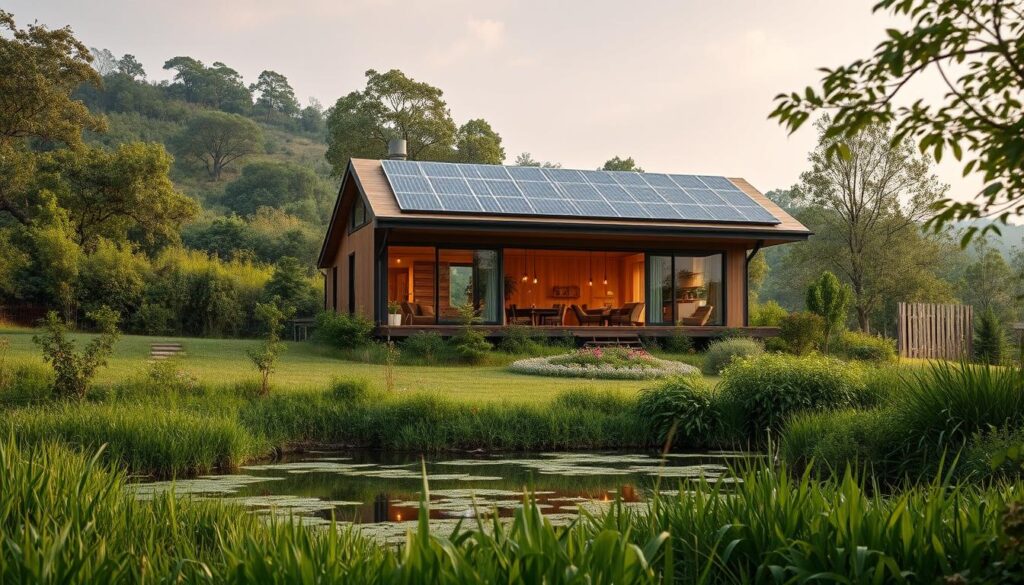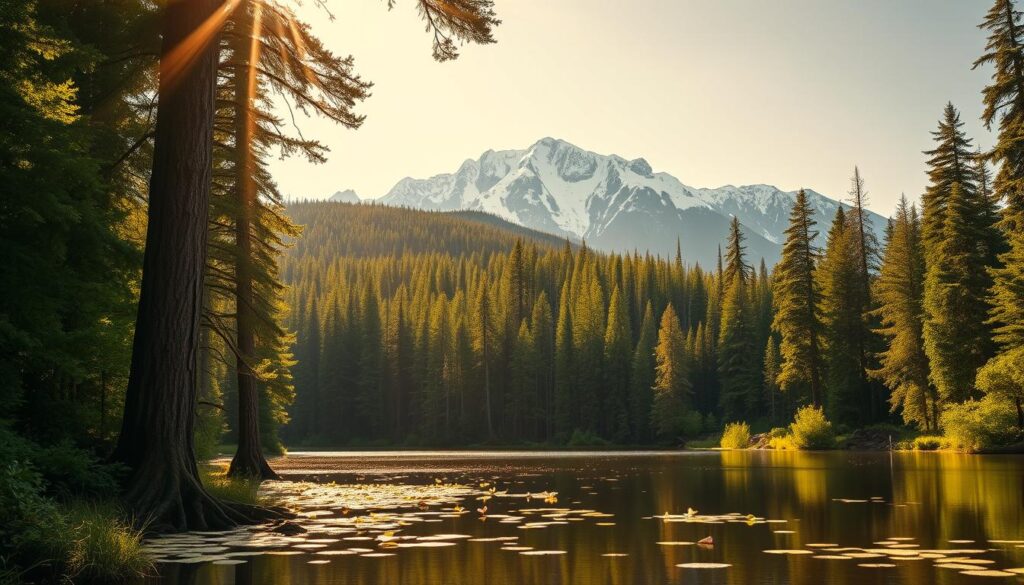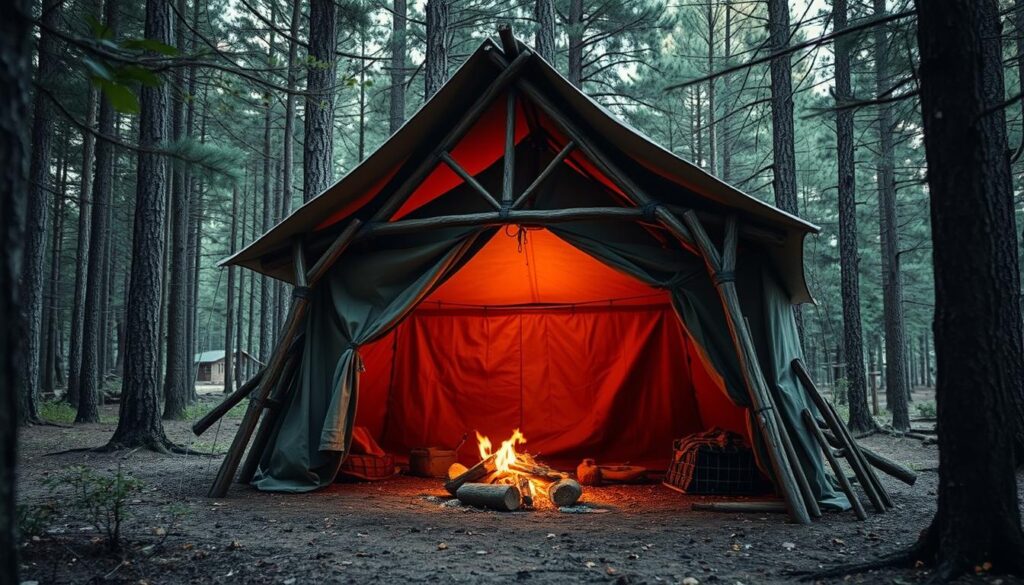Thinking about my journey to a sustainable home brings back my love for growing food. In my last blog post on my journey to sustainable living, I talked about growing my own food. It’s something I’ve done for as long as I can remember.
My quest for an eco-friendly house started with wanting to live greener. It’s not just about new habits. It’s about living simply and in harmony with nature.
Key Takeaways
- Embracing sustainable living practices
- Cultivating your own food for a more self-sufficient lifestyle
- Adopting eco-friendly habits in daily life
- Reducing environmental footprint through conscious choices
- Exploring alternative energy sources and cooking methods
Why I Chose to Pursue Self-Sufficiency
Choosing self-sufficiency was more than a decision; it was a lifestyle that fit my values. As I started this journey, I learned what the homesteading lifestyle truly means for my daily life.
Self-sufficiency is more than just living off the grid. It’s about living a whole life that’s independent and sustainable. Some see it as taking a step back to a simpler life, but in the city.
Understanding the Concept of Self-Sufficiency
Self-sufficiency means you can meet your needs without depending on others. It’s about growing your food, collecting rainwater, and making your own energy. This lifestyle connects you more with nature and makes you think more about what you use.
Motivation Behind My Decision
I wanted to live more sustainably and lessen my impact on the environment. The idea of off-grid living and its freedom drew me in. I wanted to live better and help the planet at the same time.
How Self-Sufficiency Aligns with My Values
Self-sufficiency matches my values of simplicity, resilience, and caring for the environment. By living this way, I grow personally and help the planet. This connection keeps me motivated to keep going on this path.
Assessing My Current Living Situation
To create a sustainable future, I need to understand my current home’s limitations and possibilities. This involves a detailed assessment of my living situation. It’s key to figuring out the steps to achieve an environmentally conscious dwelling.
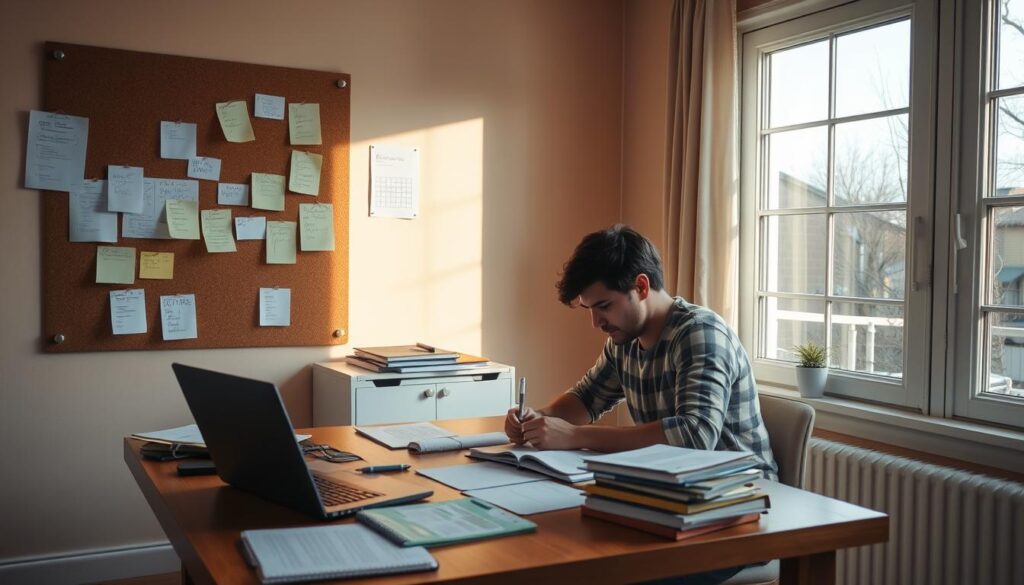
Limitations of My Existing Home
The first step is to identify my current home’s limitations. This includes looking at its energy efficiency, construction materials, and design. For example, Holly transformed her suburban house in Perth into “edible wonderlands” using permaculture principles.
Understanding these limitations helps me see the changes needed to make my home sustainable and self-sufficient.
Evaluating Available Resources
Next, I need to evaluate the resources I have. This includes looking at the natural resources around my home, like sunlight, rainwater, and soil quality. It also involves checking my financial resources for making my home more sustainable.
By evaluating these resources, I can start planning for green building design and achieving a more autonomous residence.
Setting Goals for My Self-Sufficient Destination
With a clear understanding of my current situation and resources, I can set realistic goals. This involves defining what self-sufficiency means to me and outlining the steps to achieve it.
By setting clear goals, I can create a roadmap for my journey. This will lead me to a more sustainable and self-sufficient lifestyle. I aim to achieve an autonomous residence that reflects my values and supports environmentally conscious living.
Researching Self-Sufficient Practices
To make a self-sufficient home, I started by looking into the newest in green building and energy. I checked out many sources to find the top methods for my project.
Sustainable Building Techniques
I focused a lot on sustainable building techniques. Using local materials like reclaimed wood and earth is good for the planet and makes the home unique. I also learned about passive solar design and natural insulation to cut down on heating and cooling needs.
Renewable Energy Sources
Looking into renewable energy sources was key. Solar panels were a top choice because of the sun in my area. I also considered wind and hydroelectric power, thinking about what works best for me.
Water Management
Good water management is essential. I looked into rainwater harvesting, which collects and stores rainwater for things like watering plants and washing dishes. I also learned about water filtration and greywater systems to reduce water waste.
After researching, I made a detailed plan for my self-sufficient home. It includes using green materials, setting up renewable energy systems, and managing water well.
The path to self-sufficiency keeps going, with always learning and adjusting being important. I know it’s vital to keep up with new green practices and tech to keep my home eco-friendly and efficient.
Creating a Detailed Plan of Action
Having a solid plan is key to becoming self-sufficient. I started by setting clear goals, budgeting, and setting a realistic timeline. This was essential for my journey to a self-sufficient home.
Outlining My Self-Sufficiency Goals
I first outlined my self-sufficiency goals. I wanted to cut down on public utilities and grow more of my own food. Jessica’s story showed me the importance of a clear plan and achievable goals.
To make my goals real, I broke them down into smaller tasks. For example, I aimed to grow 50% of my food within two years. This meant planning a sustainable garden and learning about crop rotation.
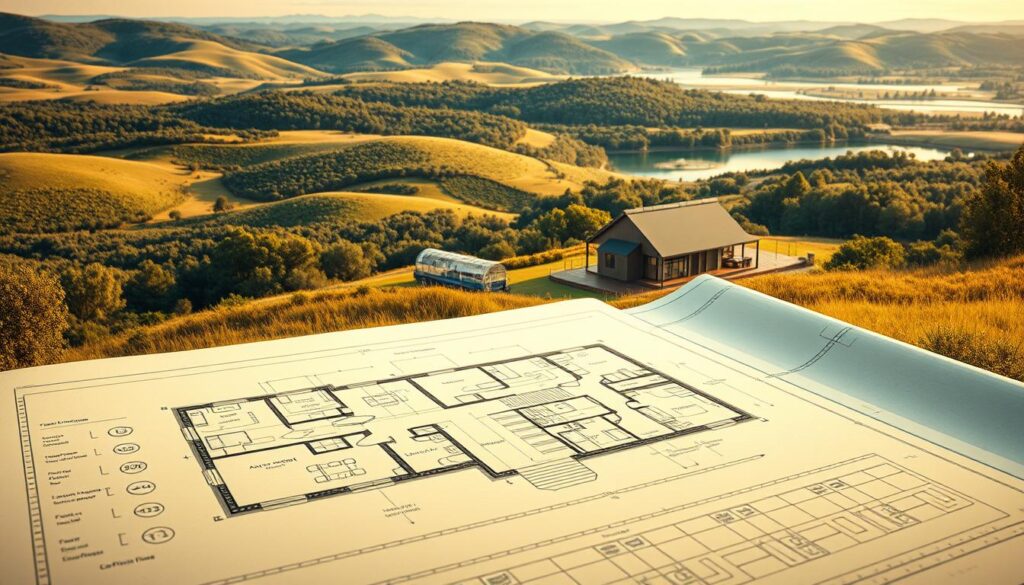
Budgeting for My Journey
Budgeting was a big part of my planning. I had to think about the costs of land, building or renovating my home, and renewable energy systems. I made a detailed budget to see where my money would go.
| Category | Initial Cost | Ongoing Expenses |
|---|---|---|
| Land Purchase | $10,000 | $0 |
| Renewable Energy Systems | $15,000 | $500/year |
| Water Management System | $8,000 | $200/year |
| Sustainable Gardening | $3,000 | $500/year |
Timeline for Implementation
Creating a realistic timeline was vital. I set short-term and long-term goals with specific milestones. For instance, I planned to install renewable energy systems in six months and make good progress in gardening in a year.
With a clear plan, budget, and timeline, I stayed on track. I was confident in my journey to a self-sufficient home, embracing the homesteading lifestyle.
Choosing the Right Location for My Dwelling
Choosing the perfect spot for my autonomous residence was a big deal. It was the base of my self-sufficient life. The location would affect my daily life and the success of my eco-friendly home.
Factors Influencing My Location Choice
Several key factors guided my choice. I looked at the land’s topography, natural resources, and climate. Knowing these was key to achieving my self-sufficient goals.
The land’s shape was important for drainage and soil stability. I also thought about sunlight, wind, and water for power and water needs.
Assessing Soil and Climate Conditions
Checking the soil and climate was essential. Soil quality affects growing food, and climate impacts heating and cooling needs. I studied local climate patterns and soil composition.
Soil tests helped me understand its fertility. This knowledge was vital for my home’s foundation and garden.
Proximity to Resources and Community
Location near resources and community was also key. Being too far from services was a challenge. Yet, being too close to cities might disrupt my peace.
I balanced being close to community with the need for solitude. Accessibility was also important to ensure easy access to supplies and services.
Designing My Self-Sufficient Home
My journey to self-sufficiency begins with designing a home that blends with nature. I aim to create a sustainable home that reduces environmental impact and improves the natural setting.
Layout Considerations for Efficiency
A well-designed layout is key for a self-sufficient home. I focus on natural light, ventilation, and insulation to cut down on artificial lighting and heating. This way, I can make a cozy living space that uses less energy.
The layout also affects the home’s functionality. For example, I plan to use passive solar design for natural heating and cooling. This means placing windows right and using materials that absorb and release heat.
Integrating Natural Elements into My Home Design
It’s important to include natural elements in my home design. This creates a balance between the built environment and nature. I aim to blend my home with its surroundings by using natural materials like reclaimed wood and stone in my green building design.
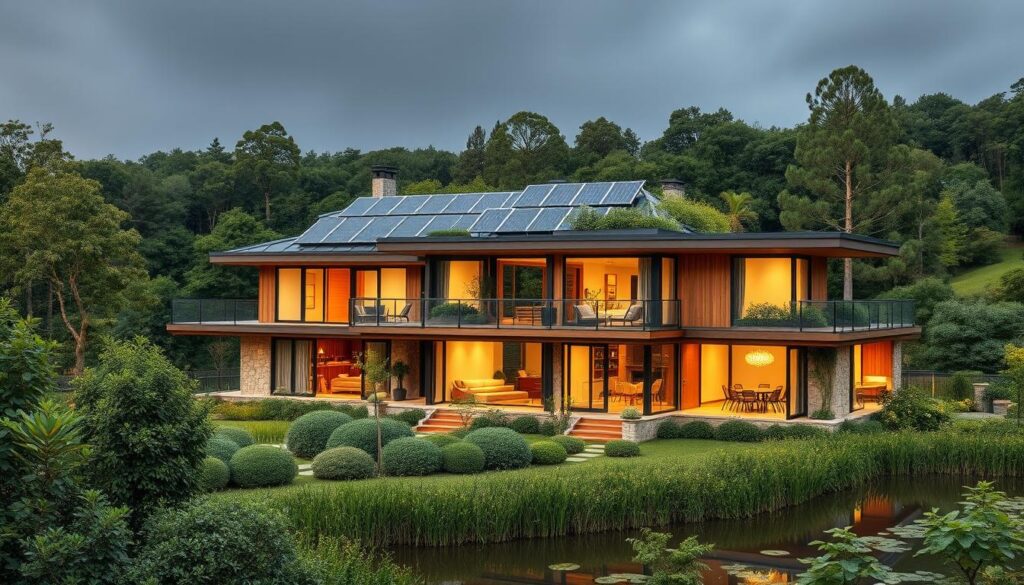
I also plan to use native plants and vegetation. This will make the property more beautiful and connect the indoors with the outdoors smoothly.
Selecting Sustainable Materials
Choosing the right materials is vital for a sustainable home. I’ll pick materials that are locally sourced, recycled, or sustainably harvested. This choice helps the environment and supports local economies.
- Reclaimed wood for flooring and walls
- Low-VOC paints and finishes
- Sustainably sourced insulation materials
- Recycled glass countertops
By choosing sustainable materials, I can build a home that’s eco-friendly, healthy, and long-lasting.
Implementing Energy Solutions
My journey to a self-sufficient home led me to focus on energy solutions. Energy independence is key for off-grid living. I’ve looked into different renewable energy sources to power my home.
Exploring solar power options was a big step. Solar energy is great for homes with lots of sunlight. I’m thinking about solar panels to cut down on grid use and bills.
Researching Solar Power Options
Solar power is clean and renewable. It uses photovoltaic (PV) panels or solar thermal systems. PV panels turn sunlight into electricity, perfect for my home.
The cost of solar panels is high at first. But, the long-term savings and lower carbon footprint are worth it.
Considering Wind and Water Energy
I’ve also looked into wind and water energy. Wind turbines and hydroelectric systems can provide reliable energy. They need a big investment and the right location.
Finding Energy-Efficient Appliances
I’ve searched for energy-efficient appliances. These use less energy but work just as well. They help me use less energy overall.
These steps are helping me live independently and reduce my environmental impact. The path to a self-sufficient home is challenging but rewarding.
Establishing a Water Collection and Management System
A key part of my home is a smart water system. It’s important for a home that doesn’t rely on outside water. This helps the environment too.
I use rainwater harvesting systems to collect water. These systems catch and store rainwater for later use. It helps save municipal water and cuts down on stormwater runoff.
Rainwater Harvesting Systems
Setting up a rainwater system needs careful planning. First, the roof must be clean and free of dirt. I use a first flush device to get rid of the first dirty water and then store the clean water.
The tank is key. I picked one that’s strong, won’t break down in sunlight, and big enough for my needs. Keeping it clean and checking for leaks is important.
Water Filtration Techniques
Rainwater is mostly clean, but it needs filtering before use. I use a system with sedimentation, activated carbon, and UV treatment. This makes the water safe for drinking and cooking.
Water filtration techniques can vary. But mixing physical and chemical methods works best. Testing the water regularly is also key to keeping the system effective.
Managing Greywater and Waste Water
Managing greywater and waste water is also important. Greywater from sinks and showers can be used for irrigation and toilets. This cuts down on fresh water use.
I have a greywater recycling system for this purpose. It treats greywater for safe use. This saves water and reduces waste. Proper handling of greywater and waste water is key for a sustainable home.
These water management steps have made my home more sustainable. It supports my self-sufficient lifestyle and helps the environment.
Growing My Own Food
Growing my own food has been key to my self-sufficiency journey. It gives me fresh produce and a sense of pride. My sustainable garden has made my home more eco-friendly and sustainable.
Planning a Sustainable Garden
Planning a sustainable garden starts with knowing your land. You need to check the soil, climate, and sunlight. This helps you pick the right crops, saving water and fertilizers.
Using companion planting is also important. It means growing plants together to help each other grow better. For example, marigolds can keep nematodes away from tomatoes, and basil makes tomatoes taste better.
- Assess your land and soil type
- Choose crops suitable for your climate
- Incorporate companion planting
Companion Planting and Crop Rotation
Companion planting is just part of a sustainable garden. Crop rotation is also key. It keeps the soil healthy, fights pests, and boosts crop yields. Rotating crops breaks disease and pest cycles, making your garden healthier.
“Crop rotation is a fundamental practice in sustainable gardening, allowing gardeners to maintain soil health and reduce the reliance on chemical fertilizers and pesticides.”
For example, growing legumes and then other crops uses the nitrogen they fix. This makes the soil more fertile.
Preserving and Storing My Harvest
After harvesting, it’s important to preserve and store your food. Methods like canning, freezing, and dehydrating keep your produce fresh and nutritious all year.
Canning lets you enjoy vegetables and fruits all year. Freezing is great for keeping nutrients in veggies like broccoli and peas. Dehydrating fruits and herbs makes them more flavorful and adds to dishes.
These practices have made my home more eco-friendly and healthy. They’re a big part of my homesteading lifestyle.
Overcoming Challenges on My Journey
My journey to a self-sufficient home has faced many hurdles. To live independently, I’ve learned to be persistent and flexible.
Coping with Setbacks
Setbacks are part of the journey. How I react to them is key. Stories like Jessica’s, who overcame big challenges, have taught me a lot. Her tale shows the value of staying true to off-grid living dreams.
Patience and Persistence
Living self-sufficiently needs patience and persistence. It’s a path that demands commitment and flexibility. By keeping my goals in sight, I can handle the obstacles of building a self-sufficient home.
Community Support
Support from the community is essential for independent living. Connecting with others who aim for the same goals offers valuable knowledge and resources. For more tips on facing challenges, check out this resource on perseverance.
FAQ
What is a self-sufficient dwelling, and how does it differ from traditional homes?
A self-sufficient dwelling is a home that doesn’t rely on public utilities. It uses renewable energy, sustainable building, and efficient water systems. Unlike regular homes, it produces its own energy, collects and manages its own water, and grows its own food.
What are the benefits of adopting a self-sufficient lifestyle?
Living self-sufficiently can save you money on energy, increase food security, and lower environmental impact. It also boosts personal growth, independence, and a sense of accomplishment. You take control of your needs and resources.
How do I assess my current living situation and identify areas for improvement?
To check your current living situation, look at your energy, water, and waste management. Do an energy audit, assess your water sources, and check your waste disposal. Find ways to improve, like installing solar panels or a rainwater system.
What are some key considerations when choosing a location for a self-sufficient dwelling?
When picking a spot for your self-sufficient home, think about the soil, climate, and resources nearby. Consider the land’s food-growing ability, rainwater collection, and energy generation. Also, check local laws and zoning rules that might affect your plans.
How do I design a self-sufficient home that is efficient and sustainable?
To design a self-sufficient home, focus on natural light and heat. Use passive solar design and green roofs. Choose sustainable materials and add energy-efficient systems, water conservation, and waste reduction.
What are some effective energy solutions for a self-sufficient dwelling?
Good energy solutions include solar panels, wind systems, and hydroelectric power. Use energy-efficient appliances, LED lights, and smart home tech to cut down energy use and boost production.
How do I establish a reliable water collection and management system?
To get reliable water, set up a rainwater harvesting system. Use water filters or UV treatment. Manage greywater and wastewater with systems like septic tanks or wetlands.
What are some strategies for growing my own food in a self-sufficient lifestyle?
To grow your own food, plan a sustainable garden. Use companion planting, crop rotation, and permaculture. Use raised beds, containers, or vertical gardens to save space. Preserve your harvest through canning, freezing, and dehydrating.
How do I overcome challenges and setbacks on my journey to self-sufficiency?
To beat challenges, be patient and persistent. Adapt to changes and seek community support. Use online forums, local workshops, and network with others to stay motivated.

